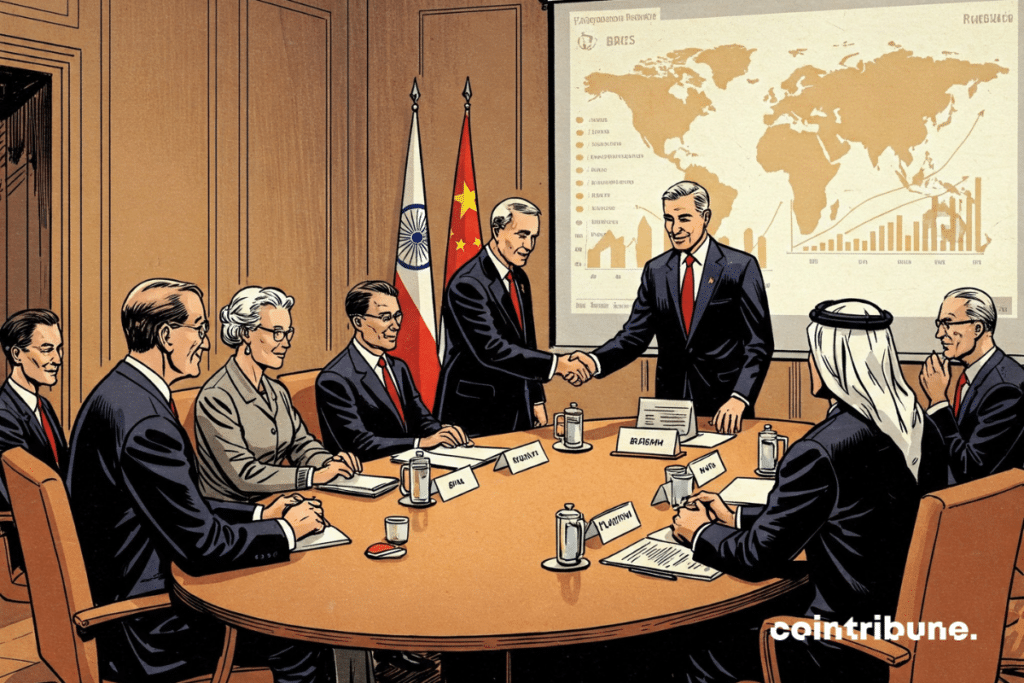Russia’s Economy Grows 4.1% Despite U.S. Embargo, Boosted By BRICS Support
While the economic sanctions aimed to choke Moscow, Russia recorded a growth of 4.1% in 2023. This figure, confirmed by the Russian authorities, shakes the certainties of Washington and its allies. In a climate of war in Ukraine and the reshaping of monetary alliances, the resurgence of the Russian economy reveals an effective circumvention strategy, driven by the BRICS. This data questions the effectiveness of Western sanctions and reshuffles the cards of the geoeconomic game.

In brief
- Russia surprises observers by showing an economic growth of +4.1% in 2023, despite the heavy sanctions imposed by the United States since 2022.
- The Secretary of the Russian Security Council, Sergey Shoigu, states that this growth could reach 4.3% in 2024, before a projected slowdown to 2.5% in 2025.
- In response to the sanctions, Russia has strengthened its rapprochement with the BRICS and launched a dedollarization strategy.
- This commercial realignment weakens the dollar and strengthens the BRICS’ position as a key player in the emergence of a new global monetary order.
An unexpected growth despite the sanctions
In a statement, the Secretary of the Russian Security Council, Sergey Shoigu, stated that “the Russian economy experienced a growth of 4.1% over the last two years”. According to him, this upward trajectory continues with an estimate of 4.3% for 2024, while projections for 2025 anticipate a slowdown to 2.5%.
This surprising performance comes in a context where the United States, supported by their Western allies, had imposed a series of heavy economic sanctions aimed to strangle the Russian economy after the outbreak of the war in Ukraine. However, these coercive measures seem to have had the opposite effect, revealing an economy capable of withstanding major external shocks.
The economic data confirm this robustness, particularly in terms of foreign trade and financial stability. Shoigu emphasizes that Russia recorded in 2023 a massive trade surplus and a remarkable growth in its exchanges:
- +3.8 billion dollars increase in foreign trade year-over-year;
- 716 billion dollars total trade volume in 2023;
- 146 billion dollars trade balance surplus;
- Reduction of external and internal debt confirmed by Russian authorities;
- A banking system considered “resilient” by Shoigu, despite exclusion from Western financial networks.
Far from being marginal, this macroeconomic stability was accompanied by an effective internal reorganization, demonstrating that Moscow was able to anticipate and absorb the effects of the sanctions. It thus poses a strategic challenge to countries that were betting on a rapid deterioration of the Russian economy.
The BRICS lever: a structured circumvention strategy
Alongside this economic performance, it is within the BRICS commercial architecture that Russia found a decisive support. From the first waves of sanctions, Moscow accelerated its integration into the BRICS alliance and implemented a deliberate dedollarization strategy.
This initiative allowed Russia to continue its international exchanges via local currencies. Russia rewrote its trade agreements to send and receive local currencies for cross-border transactions.
This reorientation was supported by partners such as China, India, and Saudi Arabia, who saw in the sanctions an opportunity to strengthen their own energy and financial autonomy.
India, for example, saved 7 billion dollars in foreign currency by purchasing Russian oil at discounted prices. As for Saudi Arabia, it imported Russian crude oil at reduced prices before redistributing it on the European market, thus securing comfortable margins.
These practices, made possible by the absence of the dollar in transactions, testify to a gradual but structured shift of the global monetary center of gravity. The Russian strategy not only allowed circumventing the sanctions, but also consolidated a multipolar dynamic where the BRICS position themselves as catalysts for new trade norms.
In the medium term, this realignment could impact currency markets, the stability of the international monetary system, and even the use of the dollar in global trade. While alternatives to the SWIFT system are being discussed, and some BRICS members are testing their own payment infrastructures, the trend towards monetary fragmentation could accelerate. In this context, cryptocurrencies could establish themselves as parallel or transitional instruments in economies seeking monetary independence.
Maximize your Cointribune experience with our "Read to Earn" program! For every article you read, earn points and access exclusive rewards. Sign up now and start earning benefits.
Diplômé de Sciences Po Toulouse et titulaire d'une certification consultant blockchain délivrée par Alyra, j'ai rejoint l'aventure Cointribune en 2019. Convaincu du potentiel de la blockchain pour transformer de nombreux secteurs de l'économie, j'ai pris l'engagement de sensibiliser et d'informer le grand public sur cet écosystème en constante évolution. Mon objectif est de permettre à chacun de mieux comprendre la blockchain et de saisir les opportunités qu'elle offre. Je m'efforce chaque jour de fournir une analyse objective de l'actualité, de décrypter les tendances du marché, de relayer les dernières innovations technologiques et de mettre en perspective les enjeux économiques et sociétaux de cette révolution en marche.
The views, thoughts, and opinions expressed in this article belong solely to the author, and should not be taken as investment advice. Do your own research before taking any investment decisions.